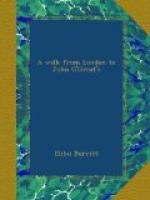to furnish a term or likeness for it. A ridgy,
spiral spire are the three most descriptive words,
but these are not half enough for stating the shape,
style and posture of this strange steeple. It
is difficult even to assist the imagination to form
an idea of it. I will essay a few words in that
direction. Suppose, then, a plain spire, 100
feet high, in the form of an attenuated cone, planted
upon a heavy church tower. Now, in imagination,
plough this cone all around into deep ridges from
top to bottom. Then mount to the top, and, with
a great iron wrench, give it an even twist clear down
to the base, so that each ridge shall wind entirely
around the spire between the bottom and the top.
Then, in giving it this screw-looking twist, bend
over the top, with a gentle incline all the way down,
so that it shall be “out of perpendicular”
by about three feet. Then come down and look
at your work, and you will be astonished at it, standing
far or near. The tall, ridgy, curved, conical
screw puzzles you with all sorts of optical illusions.
As the eyes in a front-face portrait follow you around
the room in which it is hung, so this strange spire
seems to lean over upon you at every point, as you
walk round the church. Indeed, I believe it
was only found out several centuries after its erection,
that it absolutely leaned more in one direction than
another. It is a remarkable sight from the railway
as you approach the town from a distance. If
it may be said reverently, the church, standing on
comparatively a hill, not only lifts its horn on high,
but one like that of a rhinoceros, considerably curved.
Just outside the town stands the house in which George
Stephenson lived his last days, and ended his great
life of benefaction to mankind; leaving upon that
haloed spot a
biograph which the ages of time
to come shall not wash out.
From Chesterfield I diverged westward to see Chatsworth
and Haddon Hall. Whoever makes this walk or
ride, let him be sure to stop at Watch Hill on the
way, and look at the view eastward. It is grander
than that of Belvoir Vale, if not so beautiful.
It was a pleasure quite equal to my anticipation to
visit Chatsworth for the first time, after a sojourn
in England, off and on, for sixteen years. It
is the lion number three, according to the American
ranking of the historical edifices and localities of
England. Stratford-upon-Avon, Westminster Abbey
and Chatsworth are the three representative celebrities
which our travellers think they must visit, if they
would see the life of England’s ages from the
best stand-points. And this is the order in which
they rank them. Chatsworth and Haddon Hall should
be seen the same day if possible; so that you may
carry the impressions of the one fresh and active
into the other. They are the two most representative
buildings in the kingdom. Haddon is old English
feudalism edificed. It represents the
rough grandeur, hospitality, wassail and rude romance




